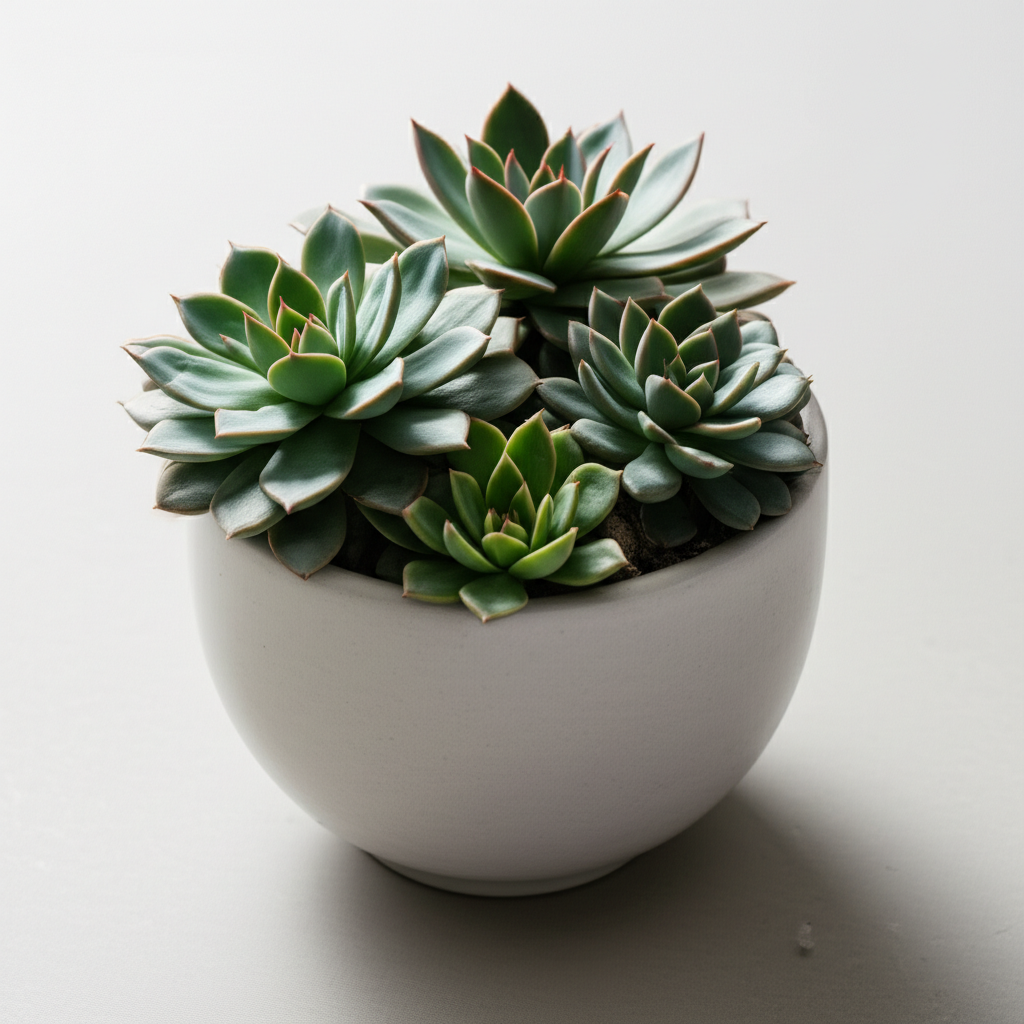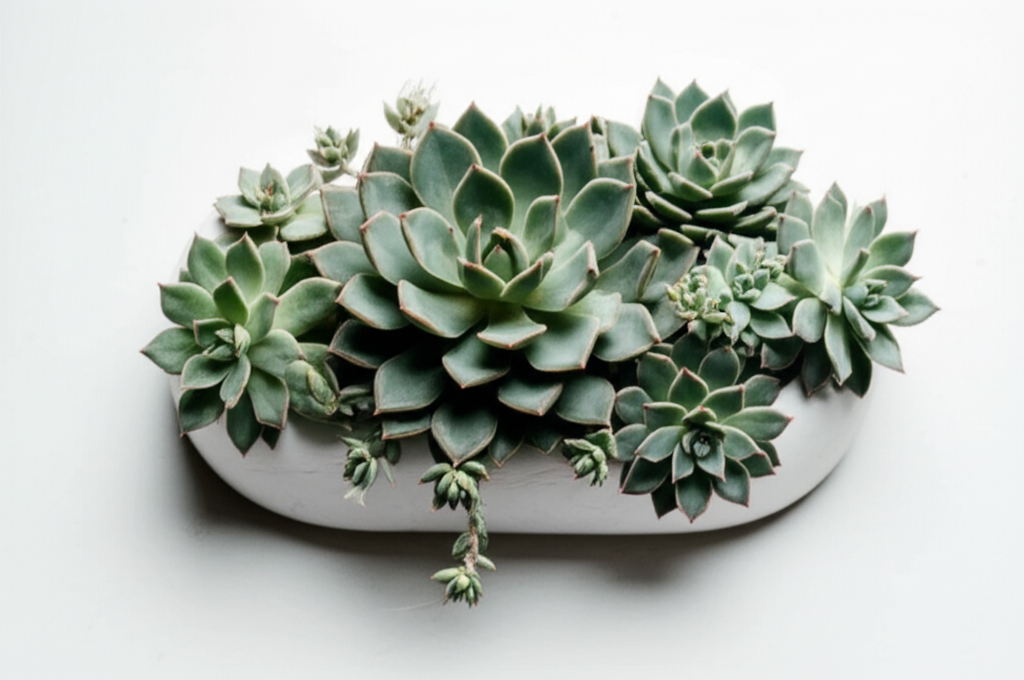The Allure of the Ice Plant Succulent
Ice plant succulents, with their dazzling, dew-drop-like epidermal bladder cells that shimmer in the sun, are a truly captivating choice for decorative arrangements. These unique adaptations, which store water and reflect light, give them an almost crystalline appearance, making them stand out from their more conventional succulent cousins. Beyond their aesthetic appeal, ice plants are remarkably resilient and low-maintenance, thriving in arid conditions and requiring minimal watering. This combination of striking beauty and ease of care makes them an ideal candidate for creating eye-catching decorative pieces that bring a touch of natural wonder into any space.
Understanding Ice Plant Varieties for Arrangements
While the term “ice plant” broadly refers to a diverse group of succulents, several species are particularly well-suited for decorative arrangements due to their growth habits, colors, and textures. Understanding these variations is key to successful and visually appealing designs.
- Delosperma: Often referred to as “Hardy Ice Plants,” these varieties are known for their vibrant, daisy-like flowers that bloom prolifically in various colors, including pink, purple, red, and yellow. They typically have a low, spreading growth habit, making them excellent for cascading arrangements or ground cover in larger displays.
- Mesembryanthemum: This genus includes some of the most iconic ice plants, recognizable by their shimmering, crystal-like epidermal cells. Species like Mesembryanthemum crystallinum (Common Ice Plant) and Mesembryanthemum cordifolium (Heartleaf Ice Plant) offer a silvery-green foliage that is both attractive and drought-tolerant. They can have a trailing or clumping growth habit, depending on the specific variety.
- Aptenia: Known for their rapid growth and trailing stems, species like Aptenia cordifolia are fantastic for arrangements where a flowing, cascading effect is desired. Their small, fleshy leaves add a delicate texture.
- Lampranthus: These ice plants are celebrated for their exceptionally bright and abundant blooms, often in shades of orange, pink, and purple. They tend to have a more upright or mounding growth habit, making them good focal points in arrangements.
Designing with Ice Plant Succulents: Principles and Inspirations

Creating compelling ice plant succulent arrangements involves more than just placing plants in a container. It’s about understanding design principles and how to leverage the unique characteristics of these succulents to create harmonious and visually stunning displays.
Key Design Principles for Succulent Arrangements
- Color Palette: Ice plants offer a range of colors, from the silvery-greens and blues of their foliage to the vibrant hues of their flowers. Consider a cohesive color scheme, whether monochromatic, analogous, or complementary, to achieve a specific mood or aesthetic.
- Texture and Form: The diverse textures of ice plants—from the smooth, almost glassy surfaces of some to the fuzzy or ridged leaves of others—provide an exciting opportunity for contrast. Mix plants with different leaf shapes and sizes to add visual interest.
- Scale and Proportion: Ensure the size of the plants and the container are in proportion to each other and to the intended display space. A delicate arrangement might suit a small bedside table, while a larger, more robust display could anchor a centerpiece.
- Focal Point: Identify a dominant plant or element that will draw the eye. This could be a particularly colorful bloom, a uniquely shaped ice plant, or even a decorative accent piece.
- Balance and Harmony: Distribute the visual weight of the arrangement evenly. This can be achieved through symmetrical or asymmetrical balance, ensuring the overall composition feels stable and pleasing.
Inspirations for Ice Plant Arrangements
- Cascading Elegance: Utilize trailing ice plant varieties like Aptenia or certain Mesembryanthemum species in hanging baskets or elevated containers. Allow their stems to gracefully spill over the edges, creating a waterfall effect.
- Textural Tapestry: Combine ice plants with different epidermal cell structures and leaf shapes. For instance, pair the shimmering, crystal-like leaves of Mesembryanthemum crystallinum with the more compact, fleshy leaves of a Delosperma variety.
- Monochromatic Magic: Focus on a single color family for both foliage and flowers. A collection of silvery-green ice plants with pops of bright pink or purple blooms can create a sophisticated and modern look.
- Desert Oasis: Mimic a miniature desert landscape by incorporating sand, small pebbles, and driftwood alongside your ice plants. This creates a naturalistic and drought-tolerant display.
- Living Jewelry: For smaller arrangements, use miniature containers like shallow bowls or even vintage teacups. Select compact ice plant varieties and focus on intricate detailing.
Crafting Your Ice Plant Succulent Arrangement: A Step-by-Step Guide
Creating a beautiful ice plant succulent arrangement is a rewarding process. By following these steps, you can ensure a healthy and aesthetically pleasing outcome.
Step-by-Step Creation Process
- Select Your Container: Choose a container that complements your ice plants and the desired aesthetic. Ensure it has drainage holes; if not, you’ll need to add a drainage layer. Terracotta, ceramic, or even weathered metal containers can work well.
- Prepare the Drainage Layer: If your container lacks drainage holes, add a layer of gravel, lava rocks, or broken pottery shards at the bottom. This prevents waterlogging, which is detrimental to succulents.
- Use the Right Soil Mix: Ice plants, like most succulents, require well-draining soil. A commercial cactus and succulent mix is ideal. You can also create your own by mixing potting soil with perlite or coarse sand in a 1:1 ratio.
- Arrange Your Plants: Before planting, arrange your chosen ice plants within the container to visualize the final composition. Consider their mature size and growth habits. Place taller or more upright varieties towards the back or center as focal points, and trailing varieties towards the edges.
- Planting: Gently remove the ice plants from their nursery pots, loosening any compacted roots. Place them in the container, ensuring the soil level is consistent with the top of their root balls. Fill in any gaps with your succulent soil mix.
- Add Decorative Elements: Once planted, you can enhance the arrangement with top dressings like decorative gravel, pebbles, sand, or small pieces of driftwood. This not only adds visual appeal but also helps retain moisture and prevent soil splash.
- Initial Watering: Water your newly arranged ice plants thoroughly until water drains from the bottom. This helps settle the soil and reduce transplant shock.
- Placement and Ongoing Care: Place your arrangement in a location that receives ample sunlight. For most ice plants, bright, indirect light or a few hours of direct morning sun is ideal. Allow the soil to dry out completely between waterings.
Key Facts and Comparison of Ice Plant Succulent Varieties
This table provides a quick overview of some popular ice plant varieties commonly used in decorative arrangements, highlighting their key characteristics.
| Variety/Genus | Common Name | Growth Habit | Key Feature | Sunlight Preference | Watering Needs |
|---|---|---|---|---|---|
| Delosperma | Hardy Ice Plant | Low, spreading, mounding | Vibrant, daisy-like flowers | Full sun | Low; allow soil to dry out |
| Mesembryanthemum crystallinum | Common Ice Plant | Spreading, low-growing | Shimmering, crystal-like epidermal cells, silvery foliage | Bright, indirect light to partial sun | Low; drought-tolerant |
| Aptenia cordifolia | Heartleaf Ice Plant | Trailing, sprawling | Rapid growth, cascading stems, small fleshy leaves | Bright, indirect light to partial sun | Low; can tolerate occasional overwatering better than others |
| Lampranthus | Trailing Ice Plant | Mounding, sometimes spreading | Abundant, brightly colored flowers | Full sun | Low; allow soil to dry out |
Pros and Cons of Ice Plant Succulent Arrangements
When considering ice plant succulents for your decorative arrangements, it’s helpful to weigh the advantages against potential drawbacks.
| Pros | Cons |
|---|---|
| Unique Aesthetic Appeal: The shimmering epidermal cells and vibrant flower colors are highly decorative and eye-catching. | Sunlight Requirements: Many varieties require significant sunlight, which may limit placement options indoors. |
| Low Maintenance: Ice plants are drought-tolerant and generally require minimal watering, making them ideal for busy individuals. | Susceptibility to Overwatering: While drought-tolerant, they can be prone to root rot if overwatered, especially in poorly draining soil. |
| Drought Tolerance: Excellent for xeriscaping or for individuals who tend to forget to water their plants. | Frost Sensitivity (for some varieties): While some ‘Hardy Ice Plants’ can tolerate light frost, many non-hardy varieties will not survive freezing temperatures. |
| Variety of Forms: Available in trailing, mounding, and upright forms, offering flexibility in design. | Pest Susceptibility: Can occasionally be affected by mealybugs or aphids, though generally robust. |
| Long Blooming Periods (for some): Varieties like Delosperma can provide continuous blooms for extended periods. | Potential for Overgrowth: Fast-growing varieties like Aptenia may require occasional pruning to maintain the desired shape. |
Care and Maintenance for Your Ice Plant Arrangements
Once your beautiful ice plant succulent arrangement is complete, proper care will ensure its longevity and continued beauty.
Essential Care Tips
- Light: Provide plenty of bright, indirect sunlight. Most ice plants thrive in conditions that mimic their native arid environments. If your arrangement is indoors, a south-facing or west-facing window is often ideal. Rotate the arrangement periodically to ensure even growth.
- Watering: The most common mistake with succulents is overwatering. Allow the soil to dry out completely between waterings. When you do water, water thoroughly until water runs out of the drainage holes. Reduce watering significantly during the dormant season (typically winter).
- Soil: Ensure the soil remains well-draining. If you notice the soil is staying wet for too long, you may need to repot with a better-draining mix or amend the existing soil.
- Temperature: Most ice plants prefer warm temperatures. Protect them from frost, as many varieties are not cold-hardy. Bring outdoor arrangements indoors before the first frost.
- Fertilizing: Ice plants are not heavy feeders. You can fertilize them sparingly during the growing season (spring and summer) with a diluted, balanced liquid fertilizer.
- Pruning and Grooming: As your ice plants grow, you may need to prune them to maintain their shape and encourage bushier growth. You can also remove any dead or yellowing leaves to keep the arrangement looking tidy. Cuttings from pruning can often be propagated to create new plants.
Troubleshooting Common Issues
Even with the best care, your ice plant arrangements might encounter occasional problems. Here are some common issues and their solutions:
- Yellowing Leaves: This is often a sign of overwatering. Allow the soil to dry out thoroughly and check the drainage.
- Mushy or Black Stems: This is a clear indication of root rot, usually caused by overwatering and poor drainage. If caught early, you may be able to salvage the plant by removing it from the soil, trimming away any rotted roots, and repotting in fresh, dry soil.
- Stretching or Leggy Growth (Etiolation): This occurs when the plant is not receiving enough light. Move the arrangement to a brighter location.
- Leaf Drop: This can be caused by several factors, including extreme temperature fluctuations, overwatering, or underwatering. Assess your care routine to identify the likely cause.
By understanding the unique needs of ice plant succulents and applying these design and care principles, you can create stunning and enduring decorative arrangements that bring a touch of frosted beauty to your home or garden.


